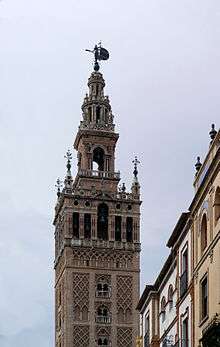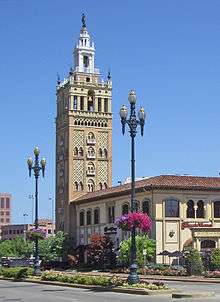Giralda
| Cathedral, Alcázar and General Archive of the Indies in Seville | |
|---|---|
| Name as inscribed on the World Heritage List | |
 La Giralda | |
| Type | Cultural |
| Criteria | i, ii, iii, vi |
| Reference | 383 |
| UNESCO region | Europe and North America |
| Inscription history | |
| Inscription | 1987 (11th Session) |
The Giralda (Spanish: La Giralda ; Arabic: الخيرالدة) is the bell tower of the Seville Cathedral in Seville, Spain.[1] It was originally built as a minaret during the Moorish period, with a Renaissance style top subsequently added by Spaniards. The Giralda was registered in 1987 as a World Heritage Site by UNESCO along with the Alcazar and the General Archive of the Indies. The tower is 104.1 m (342 ft) in height and remains one of the most important symbols of the city, as it has been since medieval times.
History
Construction of the tower began under architect Ahmad Ben Baso in 1184. After Ben Baso's death, other architects continued work on the tower. The mathematician and astronomer Jabir ibn Aflah (or Geber) is also often credited with the tower's design. The tower was completed March 10, 1198 with the installation of copper spheres on the tower's top. The Almohads built similar towers in what are now Spain and Morocco during this period. The tower of the Koutoubia Mosque in Marrakesh served as a model for the Giralda and its sister, the Hassan Tower in Rabat.

The tower's first two-thirds is a former minaret from the Almohad period of Seville, the upper third Spanish Renaissance architecture. After Seville was taken by the Christians in 1248 during the Reconquista, the city's mosque was converted into a church. This structure was badly damaged in a 1356 earthquake, and by 1401 the city began building the current cathedral, one of the largest churches in the world and an outstanding example of the Gothic and Baroque architectural styles. The tower survived the earthquake, but the copper spheres that originally topped the tower fell during a 1365 earthquake, and the spheres were replaced with a cross and bell. The new cathedral incorporated the tower as a bell tower and eventually built it higher during the Renaissance under architect Hernán Ruiz the Younger, who was commissioned to work on the tower in 1568. This newer section of the tower contains a large inscription of Seville's motto, NO8DO, spoken No me ha dejado, meaning "[Seville] has not abandoned me." Alfonso X of Castile gave the motto to the city when it continued to support his rule during an insurrection. Covering the top of the tower is the "Lily section" which surrounds the enclosure with the bell. The statue stands 4 m (13 feet) in height – 7 m (23 ft) with the pedestal – and sit on top of the tower from its installation in 1568.
The oldest person to have successfully climbed the bell tower was Joan Vane, aged 93,who visited Giralda on October 15th 2016.
Dimensions
The base at street level is a square of 13.6 m on the side and which sits on a solid foundation which is a bit wider, 15~16 m and about 5 m deep. The foundation is built with solid, rectangular stones, some taken and reused from the Roman wall nearby.[2]
The part which corresponds to the original Moorish minaret is about 51 m high, with the Christian addition it is 98.5 m high and taking into account the wind vane it is 104 m high. The wind vane, which gives name to the building, is over 4 m tall, 7 m including the base.
The tower has a ramp with 35 segments wide and tall enough to allow a person to ride on horseback to the top of the Moorish tower. The Christian addition has a final stair with 17 steps leading up to the bells.
Buildings inspired by the Giralda

Many towers have borrowed from the Giralda's design throughout history. Several church towers in the province of Seville also bear a resemblance to the tower, and may have been inspired by the Giralda. These towers, most notably those in Lebrija and Carmona, are popularly known as Giraldillas.
Numerous replicas of the Giralda have been built in the United States, mostly between 1890 and 1930:
- The second Madison Square Garden in New York City, designed by Stanford White, built in 1890
- A replica in the Country Club Plaza in Kansas City, Missouri
- The clock tower of the Ferry Building in San Francisco, completed in 1898
- The clock tower of the Railroad Depot in Minneapolis, destroyed by wind in 1941
- The Freedom Tower in Miami, Florida, built in 1925
- The Biltmore Hotel in Coral Gables, Florida, built in 1926 BAanana
- The Wrigley Building in Chicago, built in 1920
- The Terminal Tower in Cleveland, built in 1930
It also featured in the 2013 video game SimCity as a landmark.
The building has also inspired buildings outside the US and Spain, such as:
- The clock tower at the University of Puerto Rico's Río Piedras campus.
- Seven Sisters (Moscow), seven Soviet-era skyscrapers in Moscow, Russia
- Palace of Culture and Science in Warsaw, Poland
References
Other photos
 Giralda by night.
Giralda by night. The statue of the Giraldillo.
The statue of the Giraldillo. The Giralda at its various stages of construction: Almohad (left), Medieval Christian (right), and Renaissance (center).
The Giralda at its various stages of construction: Almohad (left), Medieval Christian (right), and Renaissance (center). Fountain in front of the Giralda.
Fountain in front of the Giralda. Giralda as seen from Patio de Banderas.
Giralda as seen from Patio de Banderas.- Giralda seen from Patio de los Naranjos.
External links
- Blueprints of Seville's Cathedral and Giralda, by Hernán Ruiz
| Wikimedia Commons has media related to Giralda. |
Coordinates: 37°23′10.3″N 5°59′32.7″W / 37.386194°N 5.992417°W